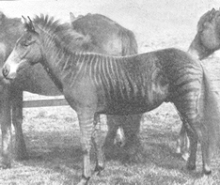Zebroid
| Zebroid | |
|---|---|
 |
|
| A zorse in an 1899 photograph, "Romulus: one year old", from J. C. Ewart's The Penycuik Experiments. | |
| Scientific classification | |
| Kingdom: | Animalia |
| Phylum: | Chordata |
| Class: | Mammalia |
| Order: | Perissodactyla |
| Family: | Equidae |
| Genus: | Equus |
A zebroid (also zedonk, zorse, zebra mule, zonkey, and zebmule) is the offspring of any cross between a zebra and any other equine: essentially, a zebra hybrid. In most cases, the sire is a zebra stallion. Offspring of a donkey sire and zebra dam, called a zebra hinny, or donkra, do exist but are rare. Zebroids have been bred since the 19th century. Charles Darwin noted several zebra hybrids in his works.
Zebroid is the term generally used for all zebra hybrids. The different hybrids are generally named using a portmanteau of the 's name and the 's name. There is generally no distinction made as to which zebra species is used. Many times when zebras are crossbred, they develop some form of dwarfism. Breeding of different branches of the equine family, which does not occur in the wild, generally results in infertile offspring. The combination of sire and dam also affects the offspring phenotype.
A zorse is the offspring of a zebra stallion and a horse mare. This cross is also called a zebrula, zebrule, or zebra mule. The rarer reverse pairing is sometimes called a horbra, hebra, zebrinny or zebret. Like most other animal hybrids, the zorse is sterile.
A zony is the offspring of a zebra stallion and a pony mare. Medium-sized pony mares are preferred to produce riding zonies, but zebras have been crossed with smaller pony breeds such as the Shetland, resulting in so-called "Zetlands".
A cross between a zebra and a donkey is known by many terms including: zonkey, zebonkey, zebronkey, zebrinny, zebrula, zebrass, zedonk, and zebadonk. Donkeys are closely related to zebras and both animals belong to the horse family. These zebra donkey hybrids are very rare. In South Africa, they occur where zebras and donkeys are found in proximity to each other. Like mules, however, they are generally genetically unable to breed, due to an odd number of chromosomes disrupting meiosis.
...
Wikipedia
